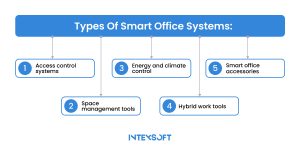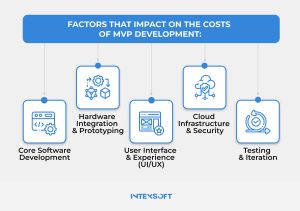
Thinking about upgrading to a smart office automation system? This article includes everything you need to know—key types, features, benefits, and what it might cost. Starting with a Minimum Viable Product (MVP) lets you test different features and figure out what actually works for your business before going all in. Need more insights or a second opinion? Contact us—we’ve got the details.
Reading time: 14 min.
In just a few years, society has been pushed headfirst into the digital age. Not gradually. Not cautiously. But with a force that reshaped industries overnight. Today, innovation is the measure of survival. The Internet of Things has quietly become a part of daily life, from smart TVs to voice-controlled assistants. Millions now use these devices, benefiting from their convenience. And as that comfort with smart tech grows at home, the demand for it in the workplace is inevitable.
For business leaders, the equation is simple: more efficiency, higher productivity, and fewer wasted resources. The tools exist to make that happen. The only real question is whether companies will adapt or be left behind. A smart office became the next step forward.

In this article, IntexSoft takes a hard look at the role of MVP in new smart office automation—what works, what doesn’t, and what needs to come first. The goal is to identify the features that deliver real value.
Smart office technology handles the mundane tasks that once demanded attention. Through the integration of IoT sensors and artificial intelligence, these systems adjust lighting and climate. They also track energy consumption and monitor the condition of office equipment. And there is more than that.
The shift toward a smart office management system is a direct response to the evolving nature of the workplace. The rise of remote work, hybrid models, and activity-based workspaces has made it clear: employers need a more connected workforce than ever. To keep pace, the ecosystem of platforms and technology solutions that underpin these offices must provide the agility.
There are five primary systems at the core of the smart office movement, and they’ve become nearly ubiquitous in today’s workplaces:

Together, these types create a workplace that adapts in real-time, where efficiency, security, and comfort are built into the very infrastructure.
Access control systems are one of the first lines of defense in a smart office. They let employers regulate who enters different areas of the office, ensuring security without the need for a physical key or card. These systems are often powered by biometrics or mobile credentials, adding convenience without sacrificing safety.
Space management tools take the guesswork out of how office spaces are used. By tracking everything from desk availability to meeting room bookings, these tools help maximize space and streamline how employees interact with the environment. It’s about giving people the right space at the right time, especially with hybrid work models in play.
Speaking of hybrid work, that’s where energy and climate control come into play. Smart offices use sensors and AI to adjust lighting, temperature, and even air quality based on occupancy.
And for those looking to personalize their workspace, smart office accessories like adjustable desks, wireless charging stations, and even AI-powered assistants are popping up everywhere. These are tools that help workers perform better and feel more comfortable throughout the day.
If all of these systems are turned on in the office, you will gain a truly well-connected environment.
The phrase “minimum viable product” gets thrown around a lot in startup circles, but its meaning has been diluted, repackaged, and misunderstood. Originally coined by Frank Robinson, the concept was created to streamline product development—get something into users’ hands, learn, and iterate. Simple.
But in practice, MVPs are often misinterpreted as a stripped-down prototype—a technical proof of concept. That’s not the point. An MVP isn’t about development at all. It’s about testing whether specific ideas about, for example, certain smart office improvements and novelties, have actual demand. It’s the best way to assess real benefits before sinking time, money, and resources into building something nobody wants.
Some of the most effective MVPs in history never involved a working product. A campaign testing messaging, even a well-crafted email blast—these can be MVPs. The goal isn’t to perfect a product but to gauge interest, gather real-world data, and understand what office workers actually need.
Projects that get this wrong spend months refining a prototype, convinced they’re validating an idea when, in reality, they’re just building in the dark. An MVP should only prove whether someone needs the solution regularly. Everything else is secondary.
Cutting through the noise and focusing on core functionalities deliver immediate value. Here’s what matters:
Here’s why minimum viable product matters.
| Benefit | Description |
| Cuts Through the Hype—Fast | Too many companies invest in “smart” technology that ends up being anything but. Consider an MVP as a filter. Instead of rolling out a full-blown automation overhaul, businesses can test real-world impact on a small scale. What works? What doesn’t? An MVP answers those questions before serious money. |
| Saves Money by Avoiding Bad Investments | Fancy IoT devices, AI-driven analytics tools—purchased with big promises, forgotten within months. An MVP forces companies to prove the reasonability of investments. If a feature doesn’t deliver measurable improvements, it doesn’t make it to the next round. |
| Identifies the Real Problems | Companies often misdiagnose their own pain points. Is security actually the issue, or is the real problem inefficient space management? An MVP provides data, not guesses. |
| Gets Employee Buy-In Early | Top-down tech rollouts fail when employees don’t use them. An MVP lets teams test automation tools, offer feedback, and help shape the system before it’s permanent. If employees see direct benefits—easier desk booking, fewer pointless meetings, smoother workflows—they’ll actually use the technology. |
| Creates a Scalable Blueprint | Smart office automation isn’t one-size-fits-all. A law firm’s needs differ from a startup’s. An MVP allows businesses to build a tailored system based on what actually works for them. |
Decisions define outcomes. What gets built now, what gets refined later, and what gets scrapped altogether—these choices don’t just shape the product. They determine whether it becomes a cost-saving asset or an expensive misstep.
Regardless of scale, certain factors always drive the final cost. They aren’t optional. They’re fundamental. Here’s why.

Let’s be real—software is the brains behind any smart office system. It connects IoT sensors, automates climate control, boosts energy efficiency, and keeps everything running smoothly. But building that kind of system isn’t simple. It takes skilled engineers who know both the tech and how it works in real offices. That’s why the cost comes down to complexity and the level of expertise needed to get it right.
Smart office systems rely on physical components—smart thermostats, occupancy sensors, lighting automation, and security devices. An MVP must be tested with real-world hardware, meaning expenses go into prototyping, compatibility testing, and API integrations.
Employees interact with the system daily, making intuitive design non-negotiable. A confusing dashboard or an app with sluggish response times kills adoption. The MVP phase requires investment in UX research, wireframing, and front-end development to ensure the system is usable from day one.
Smart offices generate data—tons of it. Storing, processing, and protecting this data in the cloud (or hybrid solutions) involves server costs, encryption measures, and compliance protocols to avoid future regulatory headaches.
The MVP isn’t a final product; it’s a proving ground. Usability tests, performance optimizations, and bug fixes add to development costs but prevent costly rollbacks later.
The challenge is building a smart office MVP and striking the right balance between features, cost, and scalability. Every choice matters. The goal is to find what delivers the most value for your business without wasted spending or unnecessary complexity.
At IntexSoft, we don’t just develop smart office systems—we use them. Every our office runs on the technology we’ve built, and the results speak for themselves. Efficiency is what happens when automation works. Our WorkSpace software keeps daily operations seamless, optimized, and intelligent. Employees don’t think about the system—it just works.
For companies serious about smart office solutions, outsourcing to experts is a truly wise move. We’ve built it, tested it, and perfected it. Now, we can build it for you.
Let’s talk today. Contact us for expert advice.